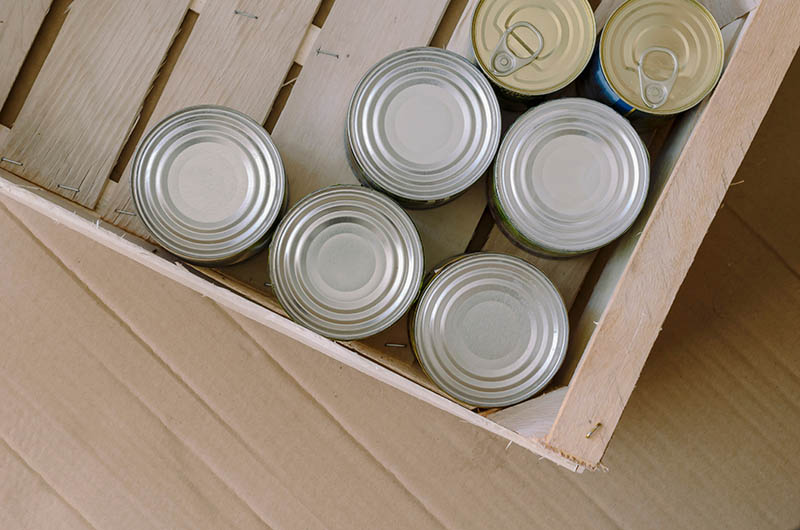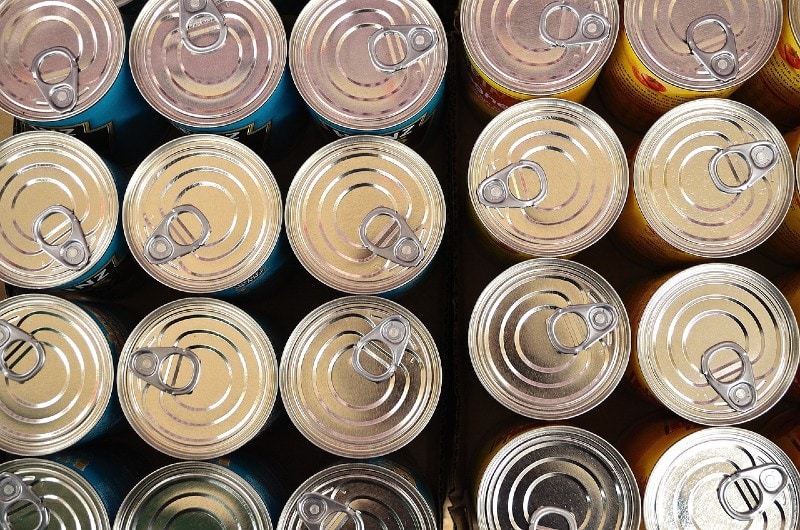What’s the Ideal Temperature for Storing Dry Goods?
-
Pete Ortiz
- Last updated:

With the recession looming over, people are stocking up on clothes, toiletries, and dry goods. Grains, cereals, and canned food can last for many months, if not years. Dry goods are very easy to store in a dark and dry spot: no need to put them in a refrigerator or a freezer. You will have to keep the right temperature in the room, though.
Otherwise, most of the products will go bad. So, what’s the ideal temperature for dry goods? Does the time of the year matter? Should you be worried about humidity levels? How do you increase or decrease the temperature in a room? And finally, what’s the best place for keeping dry goods? We have the answers right here!
Normal Temperature for Storing Goods
Proper temperature is imperative for keeping food fresh and taming bacterial growth. If you manage to maintain the temps within acceptable limits, the goods will not only last longer but also retain most of the nutrients. Now, dry goods are best kept at slightly cooler temperatures. Ideally, you should aim for 50°F. That will maximize the shelf life of your products. But, you can store most goods at indoor temps as well. We’re talking about 65–80°F.
And to be able to track temperature fluctuations, put a thermometer on the wall in the room/area where you’re planning on storing the dry goods. The perfect temperature will differ slightly depending on the area that you live in and the season. Here’s a more detailed look at recommended temps and some quick tips and tricks for storage:
- Store dry goods at 50–70 degrees F
- Use a thermometer to check the temps daily
- Protect dry goods from extensive heat/light
- Place the products on shelves, off the floor
- Store the goods away from the walls
- Ensure proper ventilation of the area
- Clean regularly to fight off pests
- Keep the original packaging

Normal Temperature in Winter
Even if you live somewhere in Florida or Louisiana, winter will still be the coldest time of the year. And that’s great news because the lower the temperature in the storage area, the better. You shouldn’t let the temps drop below the freezing point, of course, which makes 40–50°F the perfect climate for dry goods.
Normal Temperature in Spring
During the spring, snow and ice start to melt while the ground grows softer and that has a huge impact on the temperature. If you’re storing dry goods somewhere in a garage, shed, or basement, the humidity will be a factor to consider. And, since low temps equal low humidity and dry air, you should go for 50–55°F.
Normal Temperature in Summer
Summer is the hottest time of the year, but dry goods aren’t big fans of above-average temps. That’s why an air conditioner or a ceiling fan will come in handy. It might be a bit challenging to keep the temperature at 50°F; so if you manage not to let it go above 60–65 degrees during the summer, that will be great. Moving the food to the basement could also help.
Normal Temperature in Fall
Fall is the most humid season. In many ways, it’s like the golden middle between spring and winter. Therefore, 45–60°F is what you should opt for. Check the thermostat at least once a day and consider investing in a dehumidifier to fight moisture.
Why Does Temperature Matter?
Temperature is one of the defining physical quantities on our planet. We use it to measure and describe hotness and coldness. Temperature affects every single living organism on the planet. It also has a huge effect on trees, bushes, plants, and dry goods. To maximize the shelf life of various products, the temperature in the storage area needs to be in the cool-moderate range: that’s 50–70 degrees Fahrenheit.
When the temperature is too high, the deterioration rate of the food accelerates; the packages will break down faster as well. This is especially true for canned foods. If you go over 95°F, the rapid growth of yeast and molds will follow. And what if it’s really cold? Well, dry foods can be frozen without any concerns. The same can’t be said about canned foods, though. When the temps are below freezing, the cans tend to swell and bulge, resulting in the development of foodborne germs and illnesses.

What About Humidity?
Don’t want your dry goods to go to waste? Then keep humidity levels low. This might come as a surprise, but excess moisture will quickly lead to the development of bacteria and mold in dry food. In the worst-case scenario, it can even affect the packaging materials. For storing dry goods, 15–20% humidity is perfect, but 50–55% will also do.
Most food will easily handle a wider range, of course (40–60%), yet it would still be best to stick to 50%. To keep humidity levels down, the storage room needs to have proper air circulation. If that doesn’t help, get your hands on a dehumidifier. These devices come at a reasonable price and do a decent job of “taming” humidity. Moisture-proof packaging (like airtight containers) is also an option.
How to Increase/Decrease the Temperature?
Depending on the time of the year, the storage room might be too cold or too hot for dry goods. Thankfully, there are tried-and-true tricks for controlling the temps.
- Make sure the room is sealed shut. Even if your house is relatively new, there could still be cracks here and there in the walls. The windows and the doors should also be checked. During the winter days, cold air seeping through cracks can make a huge difference and force the temperature to drop. For this, we recommend using caulk or spray foam. Covering the windows with thick curtains will work as well.
- Turn up the furnace or buy a heater. Do you have a heating system that allows setting individual temps in different rooms? Then use this feature to boost the temperature slightly in the storage area. If not, a heater will be the best solution here. You can get one for as cheap as $40–60 (a portable, multi-mode 1500W electric heater).
- Reverse the ceiling fan. Did you know that ceiling fans aren’t only good for creating a cold breeze? That’s right! If you reverse the rotation direction (there should be a switch for that), you’ll actually boost the temperature by pushing the warm air down closer to the floor.
- Open the doors and windows. This won’t work during a hot summer day, but in winter or fall, opening even one of the doors will decrease the temperature quickly. Or, better yet, open the door that leads to a different room. This way, you’ll be able to control the temperature by letting cold (or warm) air in. Cross-ventilation is another technique that works.
- Invest in a dehumidifier. Drop moisture levels to 20–30% to achieve a cooling effect. Don’t expect this to have a dramatic impact, of course, but the dehumidifier will help control the temps.
Storing Dry Goods in Plastic vs Glass
To maximize the shelf life of dry goods, go with glass. The reason: glass is capable of creating a tight seal that won’t let any air in. The same can’t be said about plastic, though. And when oxygen “squeezes” into a container or jar, it makes the food deteriorate faster. Plastic is cheaper, however. So, if you’re on a tight budget, only use glass for food that spoils easier and use plastic for stuff like rice, buckwheat, and various grains.
Frequently Asked Questions (FAQs)
How Do You Store Dry Goods Properly?
Ideally, the storage area should be dry, dark, and cool. And, if you want the food to preserve its nutrients, don’t store it for more than 4–12 months. True, dry goods can last for many years. Still, if you’re planning on consuming them within a year, do follow the so-called “FIFO” rotation system” to make sure the food is always fresh. This is done to avoid a situation when items stocked first are served last.
Vegetables can be stored for 6–8 months; dried fruits last for up to a year.
What Are the Best Dry Goods For Storing?
Cans with lids, glass jars, plastic jars, and foil bags are all great for storing dry goods. But which foods are best suited for long-term storage?
- Grains: (wheat, rice, and quinoa) last for a long time and easily handle temperature fluctuations. On top of that, they are highly nutritious.
- Legumes: (peas and beans) have a higher shelf life expectancy. Plus, they go great with grains and are easy to cook.
- Nuts/seeds: are rich in natural fats. They are vulnerable to humidity, though—keep that in mind.
- Dry vegetables and fruits: have a shorter lifespan but last longer when frozen.g

A Quick Reference Guide
| Time of the Year | Normal Temperature |
| Winter | 40–50°F |
| Spring | 50–55°F |
| Summer | 60–65°F |
| Fall | 45–60°F |
Conclusion
Storing dry goods is a great way of making sure you won’t run out of essentials during a crisis. Dry goods like flour, sugar, rice, and grains take little space and won’t get spoiled like meat, fish, or liquid goods. The one thing that you’ll have to worry about is the temperature. Humidity also plays a big role; so, keep it under control as well.
Today, we talked about the ideal temps for storage and went over how warm or cold the room should be in winter, spring, and other times of the year. Follow our recommendations, keep an eye on the thermometer, and give yourself peace of mind knowing that there are dry goods stored in the house waiting to get unpacked!
- Gov – Proper Storage Temperatures for USDA Foods
- ASHRAE – recommended indoor temperature and humidity
- A Look at Dry Storage Temperature- Tips and Tricks
- FoodSafetyMarket – Guidelines for Dry Food Storage
- UtahStateUniversity – Food Storage Conditions
- Edu – Temperatures for Food Preservation
- OzoneHole – How to Use a Dehumidifier to Cool a Room
- OneGreenPlanet – How to Store Dry Goods Indefinitely
- Food Safety Tips for Storing and Rotating Product
- Packaging and Storing Dried Foods
- All You Need to Know About Ceiling Fan Direction
- AU – Wind ventilation and cross ventilation
- CDC – Foodborne Germs and Illnesses
Featured Image Credit: Fevziie, Shutterstock
Contents



